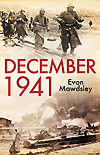
December 1941: Twelve Days That Began a World War, by Evan Mawdsley, Yale University Press, New Haven, Conn., 2011, $30
When most of us read the date December 1941, we think of the Japanese attack on Pearl Harbor, Hawaii. Evan Mawdsley has come along to broaden our view a bit.
Mawdsley, honorary professorial research fellow at the University of Glasgow, brings a remarkable breadth of vision to his task of chronicling the first 12 days of that month. Yes, he is meticulous in his description of the planning, execution and defense of the Pearl Harbor attack, but the beauty of December 1941 lies in his ability to cover the globe simultaneously. The datelines of his reportage are wonderful and varied: of course there are London, Washington, Berlin, Moscow, Tokyo and Rome but there is also Rostov (Soviet Union), Oahu (Hawaii), Hong Kong, Tobruk (Libya) and Kota Bharu (Malaya), to name a few.
The conclusion Mawdsley draws from chronicling these far-flung events is that in less than two weeks the war changed on just about every front. There were declarations of war involving Japan, the United States, Germany, the United Kingdom and Italy, which resulted in America bringing its full industrial might into the war. The Japanese scored thundering victories at Pearl Harbor, the Philippines, Malaya and Hong Kong, and in sinking HMS Prince of Wales and HMS Repulse off the Malay coast. The British began to turn the tide in North Africa with a victory at Tobruk, and the Russians made similar advances by repelling the Germans from Moscow. The Nazis would never regain the upper hand in the war. On a more sinister note, Mawdsley notes that some historians (though the author himself doesn’t seem entirely convinced) believe the official policy of Jewish extermination began when Adolf Hitler met with senior Nazis at the Old Reich Chancellery on Friday, Dec. 12, 1941.
In Mawdsley’s estimation the champions of the piece are neither Winston Churchill nor Franklin Roosevelt nor Joseph Stalin but the Japanese military leaders, as their planning was so audacious and execution so precise, especially at Pearl Harbor. “The Japanese navy’s carrier raid was, in its planning and execution, perhaps the most skillful military operation of the Second World War,” the author states. No less important was the Japanese air attack on the Philippines hours after the Pearl Harbor raid; unprepared American forces on the island nation lost 35 of 72 modern fighter planes. “This was a military catastrophe on the scale of Pearl Harbor,” Mawdsley concludes.
Not surprising, the author concludes that American and British planners were negligent in their underestimation of Japanese forces, and he is blunt in his condemnation of military leaders in Hawaii, Malaya and the Philippines, including Lt. Gen. Douglas MacArthur.
The strength of this book lies in Mawdsley’s ability to focus on the inner workings of governments and armed forces inside so many countries and cultures—from the bridge of Admiral Isoroku Yamamoto’s flagship off Hawaii to Marshal Georgy Zhukov’s headquarters at Vlasikha, Russia, as he orchestrated attacks on the Germans, to Churchill’s bedchamber as he learned of the sinking of Prince of Wales. More astonishing is the author’s ability to write with authority on so many aspects of the war—politics, international relations, geography, culture and military strategy. He even manages to imbue his story with the personal struggles and dramatic arc of several characters, such as Yamamoto, Zhukov and Churchill.
The author does commit some factual errors in covering so much ground. George Marshall, for example was not the U.S. secretary of war but its Army chief of staff. Overall, though, Mawdsley convincingly demonstrates that World War II comprised several concurrent Greek dramas, each climaxing during those essential 12 days in December 1941.
—Peter Moreira




